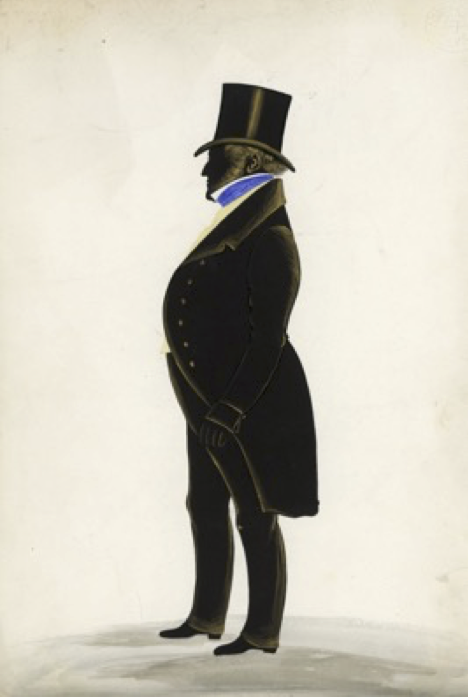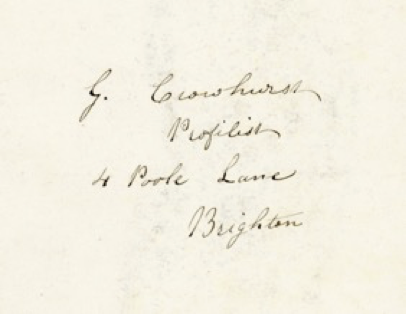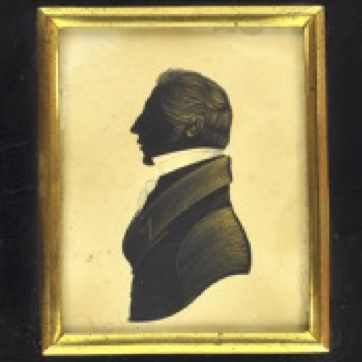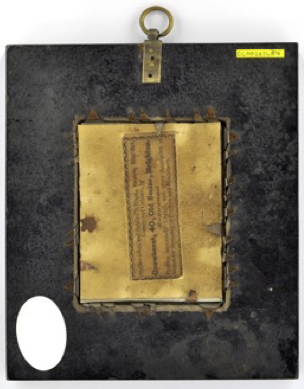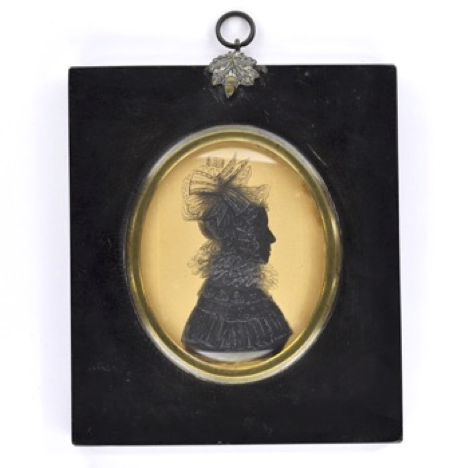GEORGE ‘ANGELO’ CROWHURST (1795-1839) WRITING MASTER & PROFILIST
Research conducted in 2021 has revealed several previously unknown aspects of the Brighton profilist’s history, including another work address.
Born in Sussex in 1795, GC is known as a Brighton-based profilist. The first record of him in the town is as a Writing Master in February 1823. Turning to profile painting ca 1827-8, it was long assumed he worked into the mid-1840s; however, it is now known he died in January 1839.
A competent artist executing cut, painted and coloured works, bust size and full-length, he also painted conversation pieces, and one work on ivory is recorded. A full-length highlighted silhouette of the Duke of York and George the Fourth is in the National Portrait Gallery collection.
When sometime resident profilist George Atkinson quit Brighton ca.1827, Crowhurst would occupy the same building, working there till his death. An effective copyist, Crowhurst’s bust size profiles are very similar to Atkinson’s, making attribution without a Trade Label, signature or date problematic.
PARENTS/SIBLINGS
James Crowhurst, born Arlington, Sussex 1749; dec. Rotherfield, Sussex 1826.
Martha Henty, born Chiddingly, Sussex 1754; dec. Hartfield, Sussex 1835.
It seems likely James was a tenant farmer as Land Tax records of 1798 show him farming land owned by a Thos. Haines in Framfield, Sussex. The couple had 12 children: 6 daughters and 6 sons. All bar one survived to adulthood.
The 1841 Census has two of GC’s brothers farming in Framfield, while another was an agricultural labourer in the same village.
GEORGE CROWHURST
Bapt.16.03.1795 Framfield, Sussex; dec. 26.01.1839 3 York Place, Brighton.
George was the tenth child born to James and Martha. It appears neither George nor his siblings were christened with middle names. ‘Angelo’ rarely appears on GC’s signed works and not at all on his printed trade labels or directory entries, suggesting he adopted the name. Certainly, he had a fondness for it as his youngest son was baptised Raphael Angelo.
When GC departed Framfield is unknown, but by spring 1822, aged 27, he’s in the Sussex county town of Lewes.
MARRIAGE
07.05.1822. GC marries Hannah Gurr Morris (1790-1860) at All Saints, Lewes. Five years older than GC, Hannah also came from Framfield and was one of nine children. Her middle name was her mother’s maiden name. Her own maiden name was bestowed on two of her sons.
Though newspaper archives have so far found no record, it’s possible that before his marriage GC lived in Lewes as one of his sisters married in the same church in 1820. However, by the beginning of 1823, GC is recorded in Brighton and would remain there for the rest of his life.
OFFSPRING
GC/Hannah had 7 children. 4 died in infancy. All were baptised at St.Nicholas, Brighton.
* Hannah: bapt. 22.02.1823; marr. 16.01.61; bur. 02.01.1865 at St. Nicholas. No issue.
* Morris: bapt. 25.06.1825; bur. 14.12.1826 at St. Nicholas.
* Maria Louisa (Lucy): bapt. 28.02.1828; bur. 27.04.1829 at St.Nicholas.
* George: bapt. 06.11.1829; bur. 29.07.1830, St. Nicholas.
* Anthony Morris: bapt. 03.12.1830; marr. 07.02.1852; d. 18.02.1879 at Camberwell Lunatic Asylum.Issue.
* Raphael Angelo: bapt. 13.02.1833; marr. 1893; died. 02.05.1899 at Brighton. No issue.
* Susanna Josephine: bapt.07.08.1835; bur. 23.12.1836 at St. Nicholas.
As seen above, the St. Nicholas baptismal register records George, a son of George and Hannah Crowhurst “Writing Master” of Devonshire Street, bapt. 06.11.1829. However, exactly a fortnight later, George Crowhurst “Profile Man” of Old Steine and “Susanna” registered the baptism of their son George! As the “Writing Master” and “Profile Man” are one and the same, one wonders how Crowhurst smoothed over the matter with wife Hannah. No further records of illegitimate son George or “Susanna” have been located.
CAREER (fl 1828- 1838)
The St. Nicholas baptismal register gives a useful timeline for GC’s changing occupations and abodes:
* February 1823/June 1825, GC is recorded as a Writing Master of High Street, Brighton.
* February 1828/November 1829, is recorded as a Writing Master of Devonshire Street, a thoroughfare then only partly built up. High Street/Devonshire Street are just east of the Steine, the fashionable promenade for visitors, opposite the king’s pavilion and the location where GC worked as a profilist until his death.
* November 1829/December 1830, GC is listed as a Profilist of Old Steine.
* February 1833/August 1835 GC is listed an Artist of London Road. This almost certainly was 3 York Place, where he died in 1839.
WORK ADDRESSES
GC’s family homes in Devonshire St and later York Place were a short stroll to his known workplaces at 4 Poole Lane and No. 11/ No. 40, Old Steine. By 1828, he had stepped into the vacuum left by the well-known profilist George Atkinson, who for reasons unknown had departed the town. In turn, both men used No. 40 Old Steine as a work address. Adjacent to the recently built Royal York Hotel It was in a prime position to attract custom and contemporary Brighton newspapers show the upper stories of the building accommodated seasonal visitors.
In March 2021 a signed full-length profile by GC came to light bearing a previously unknown address - 4 POOLE LANE BRIGHTON. Pool Lane, a few metres to the south west of Crowhurst’s later 40 Old Steine workplace, would have been his first working address as a profilist.
Both images above from a Private Collection
Interestingly the itinerant profilist J Neville is recorded working at 4 and also 7 Poole Lane. A dated profile has him operating from ”The Royal Profile Rooms” in March 1827, so it seems likely these “Rooms” were in Poole Lane. A year later in October 1828, Neville was probably the “Mr Neville” recorded with the travelling “ Percival Gallery “ in Birmingham.
So it seems certain Crowhurst occupied the premises after Neville’s departure in 1827, then moved to 40 Old Steine after George Atkinson vacated this more fashionable address the following year.
Regarding Crowhurst’s Old Steine addresses, virtually all his signed works bear No. 40 Old Steine – either handwritten or printed. As far as is known, just a single profile bears No. 11 Old Steine.
Both images above from a Private Collection
Directories record No. 11 as a private residence and it now appears GC rented a room/studio there as a stopgap due to a damaging fire at No. 40.
28/29 November 1835: THE BRIGHTON PATRIOT and THE ATLAS newspapers, among others, devote column inches to a blaze which broke out at 11pm Sunday 22nd November at No. 40. A kitchen beneath GC’s shop, used by a neighbouring confectioner, was the seat of the fire. A pair of fire engines sent to the incident were, according to, THE BRIGHTON PATRIOT under “...unskilled management...”. However, “...augmented by a party of Coldstream Guards...”, the blaze was extinguished after 4 hours.
GC removed his “...cutting machine and other articles...”, storing them at the nearby Royal York Hotel, but nearly all “...drawings and profiles were consumed and all his windows smashed...”.
The Coldstream Guards were garrisoned at Brighton between November 1835 and February 1836, and Mrs Nevill Jackson’s Dictionary of Silhouettes (1938) records the single sitter taken at No. 11 as Ensign M. J. Daniel of the Coldstreams. It’s not too fanciful to suggest he may have been one of the fire party.
15th December 1835: THE BRIGHTON PATRIOT notes a subscription got up for GC, “a great sufferer in the late fire”.
7th January 1836: the same paper prints GC’s advertisement, thanking nobility/gentry for their patronage over the previous 8 years, thanking subscription contributors and proclaiming No. 40 reopened for business. Newspapers also stated the confectioner, a Mr Phillips, was insured so it’s probable that GC was recompensed, and as the Electoral Register of 1837 still lists him – 2 years after the blaze – as a householder of London Road, the conflagration obviously wasn’t ruinous.
Image above from a Private Collection
DEATH
THE BRIGHTON GAZETTE (7 February 1839) recorded GC’s death at 3 York Place on the 26 January 1839, aged 44. He appears to have died intestate so it’s possible his demise was sudden. He was buried at St. Nicholas 02 February 1839.
© Brian Wellings 2022
